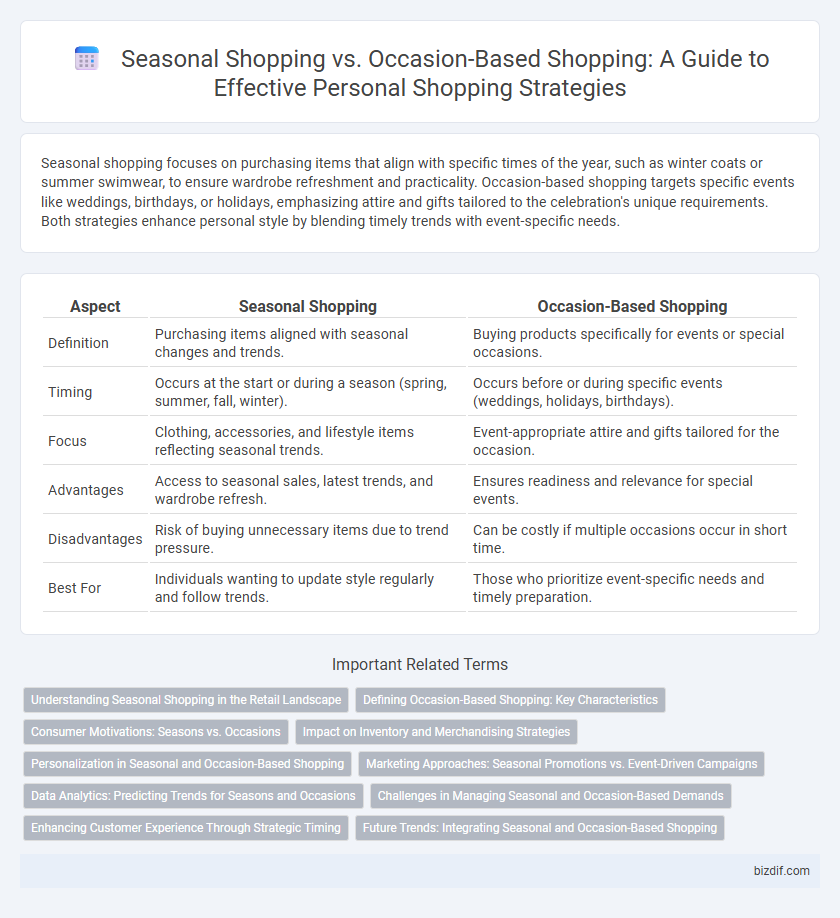Seasonal shopping focuses on purchasing items that align with specific times of the year, such as winter coats or summer swimwear, to ensure wardrobe refreshment and practicality. Occasion-based shopping targets specific events like weddings, birthdays, or holidays, emphasizing attire and gifts tailored to the celebration's unique requirements. Both strategies enhance personal style by blending timely trends with event-specific needs.
Table of Comparison
| Aspect | Seasonal Shopping | Occasion-Based Shopping |
|---|---|---|
| Definition | Purchasing items aligned with seasonal changes and trends. | Buying products specifically for events or special occasions. |
| Timing | Occurs at the start or during a season (spring, summer, fall, winter). | Occurs before or during specific events (weddings, holidays, birthdays). |
| Focus | Clothing, accessories, and lifestyle items reflecting seasonal trends. | Event-appropriate attire and gifts tailored for the occasion. |
| Advantages | Access to seasonal sales, latest trends, and wardrobe refresh. | Ensures readiness and relevance for special events. |
| Disadvantages | Risk of buying unnecessary items due to trend pressure. | Can be costly if multiple occasions occur in short time. |
| Best For | Individuals wanting to update style regularly and follow trends. | Those who prioritize event-specific needs and timely preparation. |
Understanding Seasonal Shopping in the Retail Landscape
Seasonal shopping drives up to 40% of annual retail sales by aligning product offerings with weather changes and holidays, such as winter apparel or summer outdoor gear. Retailers optimize inventory management and marketing strategies based on seasonal demand patterns, boosting consumer engagement through timely promotions. Understanding seasonal shopping behaviors enables brands to forecast trends, manage supply chains efficiently, and enhance customer satisfaction during peak shopping periods.
Defining Occasion-Based Shopping: Key Characteristics
Occasion-based shopping centers on purchasing items specifically tailored for significant events such as weddings, holidays, or birthdays, emphasizing timely relevance and thematic appropriateness. This type of shopping often involves selecting unique or specialized products that enhance the event's experience, making it distinct from routine or seasonal shopping patterns. Key characteristics include focused intent, event-driven timing, and a tendency to prioritize ceremonial or celebratory needs over general wardrobe updates.
Consumer Motivations: Seasons vs. Occasions
Seasonal shopping is driven by consumers seeking items aligned with climate changes or holidays, such as winter coats for cold weather or decorations for Christmas. Occasion-based shopping is motivated by specific events like weddings or birthdays, prompting purchases that fulfill immediate needs for those celebrations. Understanding these distinct motivations helps retailers tailor marketing strategies to boost engagement and sales during peak demand periods.
Impact on Inventory and Merchandising Strategies
Seasonal shopping drives retailers to adjust inventory levels and merchandising strategies to align with predictable demand cycles, ensuring timely stock replenishment of winter coats or summer swimwear. Occasion-based shopping requires flexible inventory management and targeted promotions for specific events like weddings or holidays, often leading to short-term, high-impact sales spikes. Retailers must balance these approaches by analyzing sales data and consumer trends to optimize product assortment and minimize excess inventory.
Personalization in Seasonal and Occasion-Based Shopping
Personalization in seasonal shopping involves curating products that align with current trends, climate changes, and festive moods, ensuring consumers receive timely and relevant suggestions. Occasion-based shopping personalization focuses on understanding the unique needs and preferences tied to specific events like weddings or birthdays, enabling tailored recommendations that enhance the overall experience. Combining data from past purchases and consumer behavior allows personal shoppers to optimize both seasonal and occasion-based offerings effectively.
Marketing Approaches: Seasonal Promotions vs. Event-Driven Campaigns
Seasonal promotions leverage predictable shopping patterns tied to holidays and weather changes, optimizing inventory turnover through targeted discounts and themed advertising. Event-driven campaigns focus on specific occasions such as weddings or graduations, using personalized messaging and limited-time offers to create urgency and enhance customer engagement. Data analytics enable marketers to tailor strategies by analyzing consumer behavior trends during seasons and events, maximizing conversion rates and customer loyalty.
Data Analytics: Predicting Trends for Seasons and Occasions
Data analytics leverages historical purchase patterns and social media trends to accurately predict seasonal shopping spikes and occasion-based demand shifts. Advanced algorithms analyze variables such as weather changes, cultural events, and consumer sentiment to optimize inventory and personalized marketing strategies. Retailers employing predictive analytics experience increased sales efficiency and reduced overstock, enhancing customer satisfaction during peak seasons and special occasions.
Challenges in Managing Seasonal and Occasion-Based Demands
Managing seasonal and occasion-based shopping demands presents challenges such as fluctuating inventory levels that require precise forecasting to avoid overstock or stockouts. Retailers must navigate unpredictable consumer behavior patterns influenced by holidays, festivals, and weather changes, complicating marketing and stock replenishment strategies. Balancing diverse product assortments to meet both seasonal trends and specific occasion needs demands agile supply chain management and targeted customer insights.
Enhancing Customer Experience Through Strategic Timing
Seasonal shopping leverages predictable trends and inventory cycles to provide customers with timely selections that match current weather and lifestyle needs, enhancing satisfaction through relevance. Occasion-based shopping targets specific events such as weddings, holidays, or graduations, offering curated options that align with distinct customer motivations and emotional triggers. Strategic timing in both approaches maximizes customer engagement and loyalty by delivering personalized experiences that anticipate consumer demands and boost purchase intent.
Future Trends: Integrating Seasonal and Occasion-Based Shopping
Future trends in personal shopping emphasize a seamless integration of seasonal and occasion-based purchasing behaviors, leveraging AI-driven recommendations to tailor selections based on both time of year and specific events. Retailers are increasingly utilizing data analytics to predict customer needs, combining holiday themes with individual occasions such as birthdays or anniversaries for more personalized shopping experiences. This convergence aims to optimize inventory management and enhance customer satisfaction by offering curated products that resonate with evolving consumer lifestyles.
Seasonal Shopping vs Occasion-Based Shopping Infographic

 bizdif.com
bizdif.com